How To Wash Microfiber Towels & Mitts Correctly | 3D Car Care
Originally Posted by MIKE PHILLIPS on July
| Credit: 3dproducts.com -
Microfiber Towels – The miracle cloth for car detailing
There’s nothing better than quality microfiber towels for detailing cars. The microscopic nature of the fibers that make up the towels is more gentle to delicate surfaces like automotive clearcoat paints and all the various plastic surfaces inside and outside of your vehicle. By miniaturizing the size of the fibers that make up a microfiber towel, you get millions of extra fibers in the same area as compared to old fashioned or old-school towels used in the car detailing industry.
Adsorb and Absorb
Microfiber is unique in that it excels and both absorbing liquids and adsorbing residues.
Absorb
The word absorb means to wick INTO itself. Microfiber towels excel at absorbing liquids like spray detailers, waterless washes and anytime you’re using a microfiber towel to dry excess standing water off your vehicle. Microfiber is able to absorb and hold up to 3 times its own weight in water and other liquids.
Here’s an example of a microfiber towel absorbing water.
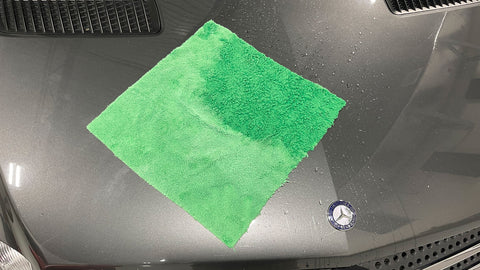
Adsorb
The word adsorb means to wick ONTO itself. Microfiber towels excel at adsorbing residues off the various surfaces of your vehicle and onto itself. For example, microfiber towels quickly and efficiently remove waxes, compounds, polishes, glass cleaners, leather and vinyl cleaners and dressings, ceramic coatings, panel wipes, spray detailers, synthetic paint sealants, etc.
Here’s an example of a microfiber towel wicking compound onto itself


Old school towels
Before microfiber towels, we all used wiping cloths that are readily available to use from around our homes or auto parts stores, these would include,
- Cotton terrycloth bath towels and hand towels.
- Cotton t shirts
- Baby diapers
- Cheesecloth
I can remember cutting up large bath towels to create smaller, easier to hold and wipe-with towels. Hand towels were already a good size to work with. T-shirts also needed to be cut-up before use, basically you would cut the sleeves off and then cut the sides and across the neck to create two wiping cloths. I never used them myself, but old-timers swear by baby diapers. And then there’s cheesecloth, which due to its open, lattice like design works great for removing sticky compounds off cars and even boats.
Bath Towels and hand towels used for detailing cars.

While most of us that have been detailing cars for a while can remember back to these old-school cloths for wiping, washing, and detailing our cars, since the introduction of microfiber these other options have gone the way of the dinosaur and as such, we hardly ever use them or read about them any longer.
Proper washing and drying is the key to longevity and performance
Unlike old school bath towels, t-shirts, diapers, and cheesecloth, which are all made from natural cotton and by its very nature is more sturdy, microfiber cloths or fibers are more delicate and require extra care when it comes to washing and drying.
Dedicated microfiber soaps
When it comes to cleaning and washing your microfiber towel collection as well as your microfiber wash mitts, you want to use a dedicated microfiber liquid laundry soap.
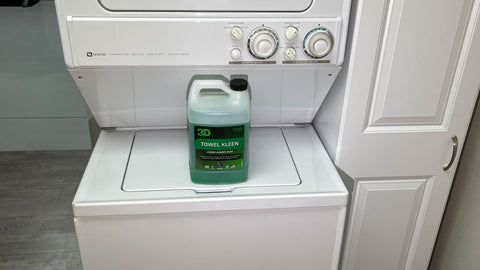
Specifically formulated for car care products
When detailing your car, a lot of the tasks include wiping some category of detailing product off a surface. In the case of car paint, this would include wiping off,
- Spray detailers and clay lubes
- Compounds, polishes, and waxes
- Panel wipes and ceramic coatings
- Leather, vinyl and plastic cleaners and dressings
- Glass cleaners
- Spray-on waxes and paint sealants
- Plastic trim dressings
- Tire dressings
- Metal polish
These are very different organic and inorganic liquids and substances and are very different than the types of contaminants that get on our clothes. When doing normal clothes laundry, you’re usually washing your clothes to remove things like body sweat, perspiration, food stains, normal dirt or grass stains, make-up, deodorants, anti-perspirants, etc. Normal laundry soap works great for normal clothes laundry.
A quality microfiber liquid laundry soap will remove all these things, but it’s formulated to also preserve the plush, soft feel of the microfiber fibers instead of making the fibers hard and crunchy. It is this aspect of a microfiber laundry soap that restores and maintains the soft, luxurious look and feel to your microfiber towel collection as well as ensuring they will last and retain their performance for hundreds and even thousands of washes.
Professional Mechanic’s Tool Chest
In the same way a professional mechanic takes care of his tool investment, for example wiping grease and oil of each tool before placing each tool back to where it goes, think of your microfiber towels as a tool investment because they are in fact tools and quality microfiber towels can be a substantial investment. Like the old saying goes,
Take care of your tools and your tools will take care of you.


Microfiber towel best practices
For the same reason we love microfiber towels, this is because they are so good at grabbing, (adsorb and absorb), onto things, (car detailing products), they are also able to grab onto the things we don’t want on them and this includes all types of contamination that can ruin a single towel as well as an entire laundry load of towels.
Avoid dropping onto the ground
It’s all to easy to drop a microfiber towel or wash mitt onto the ground when washing or drying our vehicle or when wiping off compounds, polishes, and waxes. When this happens, the towel is able to latch onto any and all dirt and debris on the ground. This can include rocks, dirt, sticks, leaves, bugs, etc. And all these things, especially dried sticks, and leaves, can intertwine and embed into the fiber weave that makes up a microfiber towel.


Because there can be millions of individual strands of microscopic micro-fibers in a single towel, it can be almost impossible to remove 100% of a dried leaf that has become crumbled-up in the towel. Then if you don’t get out all the crumbled-up leaf particulates out of the single towel that dropped and you wash this contaminated towel the rest of your towels, you will have just contaminated the entire load of towels.
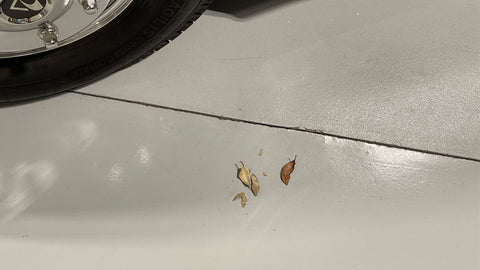



Here’s some best practices to help you maintain a pristine and clean collection of microfiber towels.
1: Avoid dropping towels onto the ground.
If you do drop a towel onto the ground – immediately inspect it for contamination. If you find contamination – remove 100% - if you cannot remove 100% of the debris – do NOT mix this towel in with the rest of your towels. Set it aside for NON-detailing work.

Here’s an example of how to repurpose a microfiber towel for non-detailing work.


2: Have a clean container to store dirty towels as you work around the car.
I like to use a clean bucket but any type of bin or even a clothes hamper will work. After using a microfiber towel, place it in the bucket or container until you’re ready to pre-wash, inspect, separate by color and then wash.


3: Clean a table for sorting and folding.
Before washing towels, place them on a clean table and then separate them by color and/or the category of products you used with the towel and wash and dry separately.
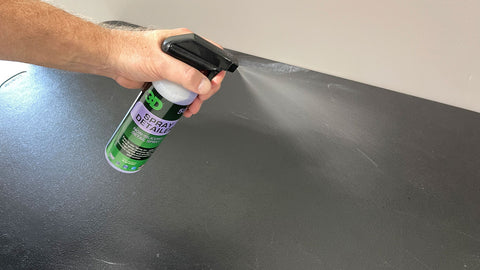




4: Pre-wash inspection.
Take a few extra minutes and look at each side of each microfiber towel for contamination. Avoid mixing any contaminated towels into a wash load as your risk contaminating ALL the towels. Larger debris can be removed using only your fingers, smaller debris can be removed using some tweezers. An ounce of prevention is worth a pound of cure.



Microfiber Wash Mitts
In the same way microfiber towels are popular for detailing cars, microfiber wash mitts are also popular for washing cars.

Pre-Rinse
You can wash your microfiber wash mitts with a load of microfiber towels but before washing be sure to hand rinse under running water to ensure any large debris is removed.

5: Use a laundry soap formulated specifically for microfiber.
Only wash microfiber towels with a dedicated microfiber laundry soap formulated specifically for washing and cleaning microfiber. This will preserve the plushness of the fibers so they don’t become coarse and crunchy over time. 3D Towel Kleen is a powerful, low foaming machine washing soap that offers excellent cleaning ability without leaving any residues in the towel. 3D Towel Kleen will also preserve the original soff, plush feel to your microfiber towels keeping the safe for use on delicate surfaces.

6: Use the warm setting to wash microfiber towels.

7: Never use fabric softeners when washing microfiber towels.
Using a fabric softener during the wash cycle will clog the weave of your microfiber towels and coat over the individual fiber strands reducing their ability to absorb and adsorb.
8: Never use bleach when washing microfiber towels.
Bleach can fade the color out of your towel collection and hinder the performance of the towels.
How to correctly wash microfiber towels
1: Set the washing machine to SMALL load, add microfiber laundry soap, and allow the basin to fill and start to agitate. This simple technique will thoroughly mix the microfiber laundry soap with the water for a uniform soap solution to ensure maximum cleaning power for the laundry load.




2: AFTER the washing machine has thoroughly mixed the microfiber laundry soap with the wash water – now add the microfiber towels to the wash basin.


3: If making a larger than SMALL wash load, select the correct size for the load of towels you placed into the washing basin and allow the washing machine to run through its washing and rinsing cycles.
NEVER OVERLOAD A WASHING MACHINE.
You need plenty of room for the soapy water solution and towels to freely swish around in order for the dirt to be released and extracted via the spin cycle. When you overload a washing machine you defeat the purpose of washing the towels.

OPTIONAL
For extremely dirty microfiber towels, after the washing machine has finished the washing cycle, but before the SPIN cycle begins, with the microfiber towels completely saturated with the laundry soap, turn the washing machine off and allow 15 to 20 minutes to go by while the microfiber laundry soap goes to work emulsifying any unwanted residues in the microfiber towels. After 15 to 20 minutes, start the WASH cycle at the beginning, and allow the washing machine to re-agitate the towels for a super clean washing load.

How to correctly dry microfiber towels
1: Select a cool to warm setting on your clothes dryer.

2: Place clean but wet microfiber towels into the dryer, close the door and start the dryer.




2: Before drying, inspect the lint trap and clean if needed.



Best Practices for drying microfiber towels.
Do not use sheet or ball style fabric softeners. Fabric softeners will clog the weave of your microfiber towels and coat over the individual fiber strands reducing their ability to absorb and adsorb.
Never use the highest heat setting on the dryer. Microfiber towels are made from a blend of polyester and polyamide, which at their core are a form of plastic. In case you didn’t already know this, if you get plastic too hot it melts! And yes, over time if you continually dry your microfiber towels on the highest heat setting on your dryer, it’s possible to harden the fibers and this will ruin your towels. It’s better to use a cool to warm heat setting to protect your towels and extend their service life.
Clean laundry Basket for holding dry towels
Make sure your laundry basket is clean before placing clean towels into it.


Inspecting – Folding – Storing
After a load of towels are dry, here’s my normal protocol to ensure clean, safe-to-use microfiber towels.
1: I use an all-purpose-cleaner, glass cleaner, spray detailer or a waterless wash and wipe down the table or workbench I use to inspect and fold my towels. It’s important to make sure the surface of the table or workbench is clean before use. Perhaps someone has used the table or workbench for some type of dirty, grimy work project, and did not clean it afterwards. Microfiber towels are easily contaminated, so always clean the surface where you inspect and fold your towels.



2: Lay each microfiber towel out flat and inspect both sides visually and tactically.

Visual inspection
Look at both sides of a towel and inspect for any form of contaminant. If you see something, try to remove it with your fingers or pick it out with a set of tweezers. If you cannot remove the contamination, then set this towel aside and dedicate it for non-detailing work.

Tactical inspection
After visually inspecting a towel, next feel both sides of the towel with your clean hands. Use your sense of touch to search for any embedded sharp, pokey, abrasive particles, or contaminants.


If discovered, try to remove the offending contaminant using your fingers or a set of tweezers. If you cannot remove the contamination, then set this towel aside and dedicate it for non-detailing work.

3: Fold towels and serpentine when stacking towels
I’ve been detailing cars for decades and as such, I’ve been washing, drying, inspecting, folding, and storing towels just as long. Here’s my tips for folding towels.
If the towel has a fluffy or fuzzy side and a flat weave on the other side, fold the fluffy side in so the flat weave is on the outside. Just an extra precaution because the fluffy side is more easily contaminated than the flat weave side.
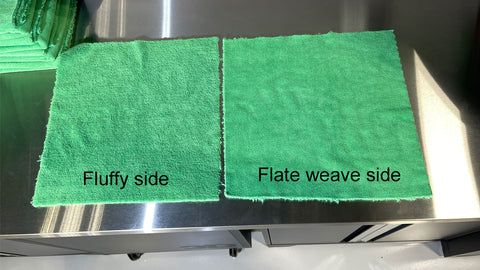
If the towel has two different sides, a fluffy side and a flat weave side, fold the towel so the flat weave side is on the outside.


When stacking folded towels, serpentine the folded towel, this means place a folded towel on the stack with the fold on one side and with the next towel, place it so the fold is on the opposite side. By doing this you’ll have a stack of towels that can stand-up in a straight direction.

If you place the folded towels with the fold side all to one side, your stack will curve and fall over. If the stack of towels falls over, some towels could land on the ground and potentially become contaminated.

Clearcoat paints are scratch-sensitive
Modern clearcoat automotive paints are harder and longer lasting compared to old-school solvent-evaporation paints like single stage lacquers and enamels used on vehicles before the 1980s. While generally speaking they are harder, they still scratch very easily. Because they are harder however, it is more difficult to remove swirls and scratches.
One of the most important things you can do to avoid putting swirls and scratches into your vehicle’s clearcoat finish is to keep your microfiber towels clean. This means doing everything you can to avoid contaminating your towels. Here’s an old saying of mine,
It takes hours to do the paint correction and buff out a car and only seconds to put swirls and scratches back into the paint.
Contaminated towels put swirls and scratches into your car’s paint. This is why you must inspect both visually and tactically your microfiber towels before using them to wipe your vehicles’ finish. Never use contaminated towels on automotive clearcoats. It’s a recipe for disaster.
4: Store clean, inspected, and folded towels in a clean place for future use. I have clean garage cabinets to store all our towels and applicator pads. If you don’t have garage cabinets, you can also use some form of plastic bins with lids. Whatever it takes, keep your towels clean.
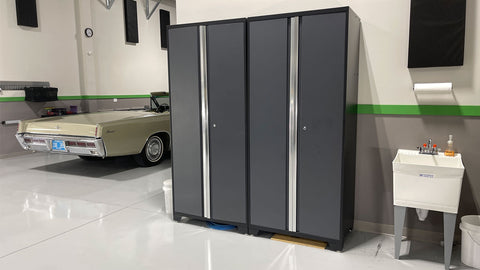
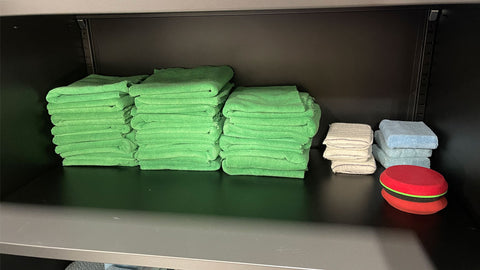
I hope the above helps you to wash and dry your towels and then inspect, fold, and store them in a way they will serve you for years to come.
